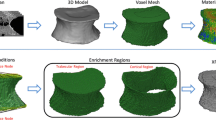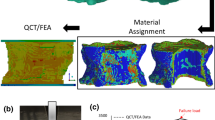Abstract
Clinical implementation of quantitative computed tomography-based finite element analysis (QCT/FEA) of proximal femur stiffness and strength to assess the likelihood of proximal femur (hip) fractures requires a unified modeling procedure, consistency in predicting bone mechanical properties, and validation with realistic test data that represent typical hip fractures, specifically, a sideways fall on the hip. We, therefore, used two sets (n = 9, each) of cadaveric femora with bone densities varying from normal to osteoporotic to build, refine, and validate a new class of QCT/FEA models for hip fracture under loading conditions that simulate a sideways fall on the hip. Convergence requirements of finite element models of the first set of femora led to the creation of a new meshing strategy and a robust process to model proximal femur geometry and material properties from QCT images. We used a second set of femora to cross-validate the model parameters derived from the first set. Refined models were validated experimentally by fracturing femora using specially designed fixtures, load cells, and high speed video capture. CT image reconstructions of fractured femora were created to classify the fractures. The predicted stiffness (cross-validation R 2 = 0.87), fracture load (cross-validation R 2 = 0.85), and fracture patterns (83% agreement) correlated well with experimental data.








Similar content being viewed by others
References
Bayraktar, H. H., E. F. Morgan, G. L. Niebur, G. E. Morris, E. K. Wong, and T. M. Keaveny. Comparison of the elastic and yield properties of human femoral trabecular and cortical bone tissue. J. Biomech. 37:27–35, 2004.
Bessho, M., I. Ohnishi, T. Matsumoto, S. Ohashi, J. Matsuyama, K. Tobita, M. Kaneko, and K. Nakamura. Prediction of proximal femur strength using a CT-based nonlinear finite element method: differences in predicted fracture load and site with changing load and boundary conditions. Bone 45:226–231, 2009.
Bessho, M., I. Ohnishi, J. Matsuyama, T. Matsumoto, K. Imai, and K. Nakamura. Prediction of strength and strain of the proximal femur by a CT-based finite element method. J. Biomech. 40:1745–1753, 2007.
Bouxsein, M. L. Biomechanics of age-related fractures. In: Osteoporosis, 3rd edn, edited by R. Marcus, D. Feldman, D. A. Nelson, and C. J. Rosen. Boston: Elsevier, 2008, pp. 601–623.
Cody, D. D., G. J. Gross, F. J. Hou, H. J. Spencer, S. A. Goldstein, and D. P. Fyhrie. Femoral strength is better predicted by finite element models than QCT and DXA. J. Biomech. 32:1013–1020, 1999.
Courtney, A. C., E. F. Wachtel, E. R. Myers, and W. C. Hayes. Effects of loading rate on strength of the proximal femur. Calcif. Tissue Int. 55:53–58, 1994.
Courtney, A. C., E. F. Wachtel, E. R. Myers, and W. C. Hayes. Age-related reductions in the strength of the femur tested in a fall-loading configuration. J. Bone Joint Surg. Am. 77:387–395, 1995.
Cummings, S. R., and L. J. Melton. Epidemiology and outcomes of osteoporotic fractures. Lancet 359:1761–1767, 2002.
Dalle Carbonare, L., and S. Giannini. Bone microarchitecture as an important determinant of bone strength. J. Endocrinol. Invest. 27:99–105, 2004.
Dawson-Hughes, B., R. Lindsay, S. Khosla, L. J. Melton, A. N. A. Tosteson, M. Favus, and S. Baim. Clinician’s Guide to Prevention and Treatment of Osteoporosis. Washington, DC: National Osteoporosis Foundation, 2008.
de Bakker, P. M., S. L. Manske, V. Ebacher, T. R. Oxland, P. A. Cripton, and P. Guy. During sideways falls proximal femur fractures initiate in the superolateral cortex: evidence from high-speed video of simulated fractures. J. Biomech. 42:1917–1925, 2009.
Genant, H. K., C. Gordon, Y. Jiang, T. F. Lang, T. M. Link, and S. Majumdar. Advanced imaging of bone macro and micro structure. Bone 25:149–152, 1999.
Goulet, R. W., S. A. Goldstein, M. J. Ciarelli, J. L. Kuhn, M. B. Brown, and L. A. Feldkamp. The relationship between the structural and orthogonal compressive properties of trabecular bone. J. Biomech. 27:375–389, 1994.
Heini, P. F., T. Franz, C. Fankhauser, B. Gasser, and R. Ganz. Femoroplasty augmentation of mechanical properties in the osteoporotic proximal femurs: a biomechanical investigation of PMMA reinforcement in cadaver bones. Clin. Biomech. 19:506–512, 2004.
Kanis, J. A., E. V. McCloskey, H. Johansson, A. Oden, L. J. Melton, and N. Khaltaev. A reference standard for the description of osteoporosis. Bone 42:467–475, 2008.
Keyak, J. H. Improved prediction of proximal femoral fracture load using nonlinear finite element models. Med. Eng. Phys. 23:165–173, 2001.
Keyak, J. H., I. Y. Lee, and H. B. Skinner. Correlations between orthogonal mechanical properties and density of trabecular bone: use of different densitometric measures. J. Biomed. Mater. Res. 28:1329–1336, 1994.
Keyak, J. H., S. A. Rossi, K. A. Jones, C. M. Les, and H. B. Skinner. Prediction of fracture location in the proximal femur using finite element models. Med. Eng. Phys. 23:657–664, 2001.
Keyak, J. H., S. A. Rossi, K. A. Jones, and H. B. Skinner. Prediction of femoral fracture load using automated finite element modeling. J. Biomech. 31:125–133, 1998.
Langton, C. M., S. Pisharody, and J. H. Keyak. Comparison of 3D finite element analysis derived stiffness and BMD to determine the failure load of the excised proximal femur. Med. Eng. Phys. 31:668–672, 2009.
Lotz, J. C., E. J. Cheal, and W. C. Hayes. Fracture prediction for the proximal femur using finite element models. Part I. Linear analysis. J. Biomech. Eng. 113:353–360, 1991.
Lotz, J. C., E. J. Cheal, and W. C. Hayes. Stress distributions within the proximal femur during gait and falls: implications for osteoporotic fracture. Osteoporos. Int. 5:252–261, 1995.
McCreadie, B. R., and S. A. Goldstein. Biomechanics of fracture: is bone mineral density sufficient to assess risk? J. Bone Miner. Res. 15:2305–2308, 2000.
Morgan, E. F., H. H. Bayraktar, and T. M. Keaveny. Trabecular bone modulus–density relationships depend on anatomic site. J. Biomech. 36:897–904, 2003.
Morgan, E. F., H. H. Bayraktar, O. C. Yeh, S. Majumdar, A. Burghardt, and T. M. Keaveny. Contribution of inter-site variations in architecture to trabecular bone apparent yield strains. J. Biomech. 37:1413–1420, 2004.
Orwoll, E. S., L. M. Marshall, C. M. Nielson, S. R. Cummings, J. Lapidus, J. A. Cauley, K. Ensrud, N. Lane, P. R. Hoffmann, D. L. Kopperdahl, and T. M. Keaveny. Finite element analysis of the proximal femur and hip fracture risk in older men. J. Bone Miner. Res. 24:475–483, 2009.
Pors Nielsen, S. The fallacy of BMD: a critical review of the diagnostic use of dual X-ray absorptiometry. Clin. Rheumatol. 19:174–183, 2000.
Schileo, E., F. Taddei, A. Malandrino, L. Cristofolini, and M. Viceconti. Subject-specific finite element models can accurately predict strain levels in long bones. J. Biomech. 40:2982–2989, 2007.
Steiger, J. H. Tests for comparing elements of a correlation matrix. Psychol. Bull. 87:245–251, 1980.
Suzuki, S., T. Yamamuro, H. Okumura, and I. Yamamoto. Quantitative computed tomography: comparative study using different scanners with two calibration phantoms. Br. J. Radiol. 64:1001–1006, 1991.
Taddei, F., L. Cristofolini, S. Martelli, H. S. Gill, and M. Viceconti. Subject-specific finite element models of long bones: an in vitro evaluation of the overall accuracy. J. Biomech. 39:2457–2467, 2006.
U.S. Department of Health and Human Services, and Office of the Surgeon General. Bone Health and Osteoporosis: A Report of the Surgeon General. Rockville, MD: U.S. Department of Health and Human Services, p. 436, 2004.
Acknowledgments
The authors thank Dr. Mark Bolander, Jim Bronk, Vincent Lambert, Dr. Xiaoliang Qin, Alexander Cong, Mike Burke, Brant Newman, Larry Berglund, Dr. Jodie Christner, Dr. Cynthia McCollough, and Elizabeth Atkinson for their valuable contributions to this study. This study was financially supported by the Grainger Foundation: Grainger Innovation Fund and NIH grant AR027065Z-30S1. The authors thank the Musculoskeletal Transplant Foundation for providing the specimens, and the Opus CT Imaging Resource of Mayo Clinic (NIH construction grant RR018898) for CT imaging of the femora.
Author information
Authors and Affiliations
Corresponding authors
Additional information
Associate Editor Sean S. Kohles oversaw the review of this article.
Rights and permissions
About this article
Cite this article
Dragomir-Daescu, D., Op Den Buijs, J., McEligot, S. et al. Robust QCT/FEA Models of Proximal Femur Stiffness and Fracture Load During a Sideways Fall on the Hip. Ann Biomed Eng 39, 742–755 (2011). https://doi.org/10.1007/s10439-010-0196-y
Received:
Accepted:
Published:
Issue Date:
DOI: https://doi.org/10.1007/s10439-010-0196-y




